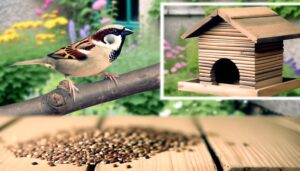10 Key Differences: Bluebird Eggs vs Sparrow Eggs
Bluebird eggs, measuring 20-24 millimeters, are notable for their larger size, commonly blue or white coloration, and thicker, denser shells with a smooth, glossy texture. In contrast, sparrow eggs are smaller (15-18 millimeters) and display a variety of hues with thinner, more variable shells and a matte finish.
Bluebirds prefer nesting in cavities within open fields, exhibiting an incubation period of 12-14 days, whereas sparrows adapt to various environments, including urban areas, with a 10-14 day incubation. These reproductive and environmental adaptations reflect distinct survival strategies and hint at more intricate ecological dynamics at play.

Key Takeaways
- Bluebird eggs are larger, measuring 20-24 millimeters, compared to sparrow eggs which are 15-18 millimeters in length.
- Bluebird eggs are typically blue or white, while sparrow eggs exhibit a wider range of colors influenced by genetics and environment.
- Bluebird eggs have thicker, denser shells with a smooth, glossy surface, whereas sparrow eggs are thinner, more variable in thickness, and slightly rough.
- Bluebirds prefer open fields and cavities for nesting, while sparrows are adaptable, nesting in dense shrubs, urban areas, and varied environments.
- Bluebird incubation lasts 12-14 days with a clutch size of 3-7 eggs, while sparrow incubation lasts 10-14 days with a clutch size of 2-8 eggs.
Egg Size Comparison

When comparing the egg sizes of bluebirds and sparrows, it is evident that bluebird eggs are generally larger, typically measuring around 20-24 millimeters in length, whereas sparrow eggs usually range from 15-18 millimeters.
This size disparity can be attributed to differences in the species' reproductive strategies and ecological niches. Larger eggs often contain more yolk, providing additional nutrients to the developing embryo, which may contribute to the relatively higher survival rates of bluebird hatchlings.
In contrast, smaller eggs, such as those of sparrows, enable the laying of more eggs per clutch, thereby increasing reproductive output. Such variations in egg size reflect the adaptive strategies these species employ to optimize their reproductive success in varying environmental conditions.
Egg Color Differences
The coloration of bluebird eggs typically manifests in shades of blue or occasionally white, attributed to the presence of biliverdin, a pigment deposited during eggshell formation.
In contrast, sparrow eggs exhibit a wider range of hues, from white to grayish or greenish with brown speckling, influenced by both genetic factors and environmental conditions.
These color variations not only play roles in camouflage and species identification but may also reflect differences in reproductive strategies and nesting habitats.
Bluebird Egg Coloration
Bluebird eggs are typically characterized by their vibrant blue or blue-green coloration, a feature that distinctively sets them apart from the more muted tones of sparrow eggs. This striking coloration results from the deposition of biliverdin, a bile pigment, during the egg formation process. The following table elucidates the color variations observed in bluebird eggs:
| Aspect | Bluebird Egg Coloration |
|---|---|
| Predominant Color | Blue or Blue-Green |
| Pigment Type | Biliverdin |
| Variability | Minimal |
| Camouflage | Moderate |
| UV Reflectance | High |
The high UV reflectance makes bluebird eggs more visible to their parents but can also attract predators. This coloration serves both an aesthetic and functional role, enhancing parental recognition while posing a trade-off with predator visibility.
Sparrow Egg Variations
Sparrow eggs exhibit a wide range of color variations, typically encompassing shades of white, gray, and brown, often speckled with darker markings. These color variations are not merely aesthetic but serve specific adaptive and reproductive functions.
For instance:
- Camouflage: The speckled patterns help in concealing the eggs from predators by blending them into their nesting environments.
- Species Identification: Variations in egg coloration can assist in distinguishing between different sparrow species, facilitating proper maternal care.
- Environmental Adaptation: Different hues and patterns can be a response to varying environmental conditions, enhancing the eggs' survival rate.
Such diversity in egg coloration among sparrows underscores the intricate balance between evolutionary adaptation and species survival strategies.
Texture and Shell Quality

When comparing bluebird eggs to sparrow eggs, notable distinctions arise in shell thickness, surface texture, and durability under pressure. Bluebird eggs generally exhibit a thicker shell, contributing to enhanced structural integrity.
Conversely, sparrow eggs often present a finer texture and comparatively lower resistance to external stress, which influences their susceptibility to environmental factors.
Shell Thickness Comparison
A comparative analysis of the shell thickness of bluebird and sparrow eggs reveals significant differences in texture and overall shell quality. The examination reveals several key findings:
- Shell Thickness: Bluebird eggs generally exhibit a thicker shell compared to sparrow eggs. This difference may be attributed to varying calcium metabolism and environmental adaptations.
- Shell Uniformity: Bluebird eggs tend to have more uniform shell thickness, enhancing their structural integrity. In contrast, sparrow eggs display greater variability, potentially impacting their fragility.
- Shell Density: The density of bluebird eggshells is higher, contributing to their robustness and lower susceptibility to breakage. Sparrow eggs, while adequate for protection, are comparatively less dense, making them more vulnerable to external pressures.
These distinctions play an essential role in the reproductive success and survivability of each species.
Surface Texture Differences
The surface texture of bluebird and sparrow eggs reveals distinct differences in their microstructural composition and tactile qualities, which are critical for their respective ecological adaptations. Bluebird eggs exhibit a smoother, glossier surface that minimizes adherence of debris and potential contaminants. This texture is attributed to a higher concentration of calcium carbonate crystals, providing a robust yet sleek exterior. In contrast, sparrow eggs possess a slightly rougher texture with a matte finish, facilitating better camouflage within their nesting environments. The variance in shell quality between the two species is indicative of their unique reproductive strategies and habitat requirements.
| Attribute | Bluebird Eggs | Sparrow Eggs |
|---|---|---|
| Surface Texture | Smooth, glossy | Slightly rough, matte |
| Composition | High calcium carbonate crystals | Mixed microstructural elements |
| Ecological Adaptation | Contaminant resistance | Enhanced camouflage |
Durability Under Pressure
Durability under pressure is a critical determinant of egg viability, with bluebird and sparrow eggs demonstrating notable differences in shell strength and resilience. Bluebird eggs typically exhibit thicker shells, which contribute to enhanced resistance against physical stress.
In contrast, sparrow eggs, while generally thinner, display a more flexible structure that adapts to varying environmental pressures.
The following aspects highlight these differences:
- Shell Thickness: Bluebird eggs have a thicker calcium carbonate layer, providing superior protection.
- Elasticity: Sparrow eggs possess a greater degree of elasticity, allowing them to withstand sudden impacts better.
- Porosity: Bluebird eggs exhibit lower porosity, reducing the risk of dehydration, whereas sparrow eggs have higher porosity, facilitating better gas exchange.
These factors underscore the distinct adaptive strategies of each species.
Nesting Locations
Whereas bluebirds typically select open fields and meadows for their nesting sites, sparrows often prefer the shelter of dense shrubs and urban structures.
Bluebirds are cavity nesters, frequently utilizing natural tree holes or man-made birdhouses. Their preference for open areas aids in their foraging strategy, primarily consisting of ground insects.
In contrast, sparrows exhibit adaptability by nesting in varied environments, including residential areas, which offers protection from predators and access to abundant food sources. Sparrows often build nests in crevices, eaves, and thick vegetation.
This divergence in nesting preferences underscores the ecological niches each species occupies, reflecting their differing survival strategies and habitat utilizations. Understanding these nesting behaviors is essential for conservation and habitat management efforts.
Incubation Period

Incubation period duration greatly influences the reproductive success and developmental timing of both bluebirds and sparrows. Bluebirds typically have an incubation period of 12-14 days, while sparrows range from 10-14 days. This variation affects several key aspects:
- Embryonic Development: Bluebirds' slightly longer incubation period allows for a more extended embryonic development phase, potentially resulting in more robust hatchlings.
- Environmental Adaptation: Sparrow eggs can hatch quicker, which may provide an adaptive advantage in unstable environments where rapid reproduction is beneficial.
- Predation Risks: Extended incubation periods can increase exposure to predators. Hence, bluebirds might employ more meticulous nesting strategies to mitigate these risks.
Understanding these differences provides insight into their evolutionary strategies and ecological niches.
Parental Care
The parental care strategies of bluebirds and sparrows reveal distinct differences in nesting habits and feeding techniques. Bluebirds typically exhibit more involved nest-building behaviors, often selecting cavities or nest boxes to provide greater protection for their offspring.
In contrast, sparrows demonstrate a more opportunistic approach, frequently utilizing a variety of nesting sites and displaying unique feeding methods to guarantee the nourishment and survival of their young.
Nesting Habits Comparison
Parental care in bluebirds and sparrows exhibits significant differences in nesting habits. Bluebirds typically show stronger territorial behavior and more involved nest maintenance compared to sparrows. Bluebirds establish well-defined territories and meticulously construct their nests, often returning to the same site annually.
In contrast, sparrows display more flexible nesting behaviors, frequently utilizing a variety of sites and materials.
Key differences include:
- Territoriality: Bluebirds are highly territorial, aggressively defending nesting sites against intruders, whereas sparrows often nest in closer proximity to conspecifics.
- Nest Construction: Bluebirds invest significant time in building sturdy, cup-shaped nests, while sparrows may use pre-existing structures or less elaborate materials.
- Site Fidelity: Bluebirds exhibit strong site fidelity, often reusing successful nests, unlike sparrows, who are less consistent in nest site selection.
Feeding Techniques Observed
Observing the feeding techniques of bluebirds and sparrows reveals distinct strategies in parental care, reflecting their differing ecological adaptations and resource availability.
Bluebirds mainly feed their young with a diet rich in insects, which necessitates frequent foraging trips. Both parents actively participate, ensuring a high protein intake essential for rapid chick development.
Conversely, sparrows exhibit a more varied diet, incorporating seeds and grains alongside insects. This dietary flexibility permits sparrows to adapt to diverse habitats and fluctuating food resources.
Importantly, sparrow parents also display cooperative feeding, yet their foraging strategy is less intensive compared to bluebirds.
These differences underscore how feeding techniques are intricately linked to species-specific ecological niches and survival strategies, optimizing offspring rearing under varied environmental conditions.
Predators and Threats

Frequently facing a myriad of natural threats, bluebird eggs and sparrow eggs are subject to predation from various species, including snakes, rodents, and larger birds. Predation represents a significant risk to the survival of these avian species, necessitating a detailed understanding of their specific predators.
- Snakes: Both bluebird and sparrow nests are vulnerable to snake predation. Snakes can climb trees and bushes to access the eggs, consuming them whole.
- Rodents: Certain rodent species, such as squirrels and mice, have been observed raiding nests for eggs, driven by nutritional needs.
- Larger Birds: Predatory birds, including hawks and crows, often target eggs for their high protein content, threatening nest success rates.
Understanding these threats is pivotal for conservation efforts.
Seasonal Variations
Seasonal variations profoundly influence the breeding patterns and egg-laying behaviors of both bluebirds and sparrows, affecting factors such as clutch size, incubation periods, and nestling survival rates.
Bluebirds typically breed in early spring through summer, with peak egg-laying occurring when food resources are abundant. This results in larger clutches and shorter incubation periods.
Conversely, sparrows exhibit more flexible breeding seasons, often extending into late summer and early autumn, allowing them to adapt to varying environmental conditions. The timing of egg-laying in relation to temperature and food availability directly impacts nestling growth and survival.
Additionally, seasonal shifts can alter predation risks and parental investment strategies, further influencing reproductive success in both species. Understanding these dynamics is vital for avian conservation efforts.
Egg Identification

Identifying bluebird eggs and sparrow eggs requires careful attention to specific characteristics such as size, coloration, and speckling patterns. Bluebird eggs typically exhibit a uniform pale blue color, although some may be white. They measure approximately 0.8 inches in length.
In contrast, sparrow eggs vary more in appearance and are usually white to pale blue or green, often adorned with fine brown speckles. They are slightly smaller, measuring about 0.6 to 0.8 inches.
Key identification markers include:
- Size: Bluebird eggs are generally larger.
- Coloration: Bluebird eggs are uniformly pale blue; sparrow eggs vary more.
- Speckling Patterns: Sparrow eggs often have distinct speckles, while bluebird eggs are usually plain.
Understanding these distinctions aids in accurate identification.
Habitat Preferences
Bluebirds and sparrows exhibit distinct habitat preferences, with bluebirds favoring open woodlands, meadows, and orchards, while sparrows are more commonly found in a variety of environments including grasslands, urban areas, and agricultural fields. Bluebirds thrive in areas with sparse underbrush, abundant perches, and cavities for nesting. In contrast, sparrows display remarkable adaptability to diverse habitats, often exploiting human-modified landscapes. This divergence in habitat selection is influenced by each species' foraging behaviors, nesting requirements, and predator avoidance strategies.
| Bird Species | Preferred Habitats | Common Characteristics |
|---|---|---|
| Bluebird | Open woodlands, meadows | Sparse underbrush, perches, nesting cavities |
| Sparrow | Grasslands, urban areas | Dense vegetation, ground feeding, adaptable |
| Bluebird | Orchards | Open spaces, available perches |
| Sparrow | Agricultural fields | Abundant food sources, varied nesting sites |
| Bluebird | Rural areas | Low human disturbance, natural nesting sites |
Breeding Behaviors

In analyzing the breeding behaviors of bluebirds and sparrows, it is evident that both species exhibit unique courtship rituals, nesting practices, and parental care strategies that are integral to their reproductive success.
- Courtship Rituals:
Bluebirds often perform elaborate displays involving flights and song to attract mates, whereas sparrows typically engage in simpler, more direct courtship behaviors, such as singing from perches.
- Nesting Practices:
Bluebirds prefer cavities or nest boxes, meticulously building nests from grass and soft materials. Sparrows, on the other hand, often nest in shrubs or man-made structures, using a variety of materials including twigs and feathers.
- Parental Care:
Both species exhibit strong parental investment, but bluebirds tend to have more defined roles, with males primarily guarding and females incubating. Sparrows often share both roles more equally.
Conclusion
In examining the differences between bluebird and sparrow eggs, substantial variations in size, color, texture, and shell quality are evident. Nesting locations and incubation periods further distinguish these avian species.
Importantly, bluebird eggs generally measure about 2.1 cm in length, whereas sparrow eggs average around 1.5 cm. Seasonal variations and habitat preferences also influence breeding behaviors and egg identification.
Such distinctions are crucial for ornithologists and ecologists in understanding species-specific reproductive strategies and environmental adaptations.






